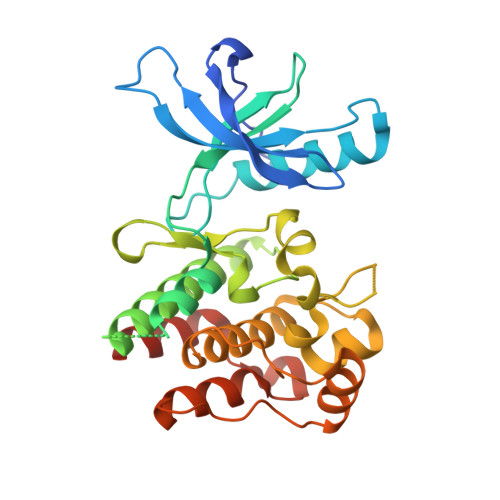Structural Insights into Pseudokinase Domains of Receptor Tyrosine Kinases.
Sheetz, J.B., Mathea, S., Karvonen, H., Malhotra, K., Chatterjee, D., Niininen, W., Perttila, R., Preuss, F., Suresh, K., Stayrook, S.E., Tsutsui, Y., Radhakrishnan, R., Ungureanu, D., Knapp, S., Lemmon, M.A.(2020) Mol Cell 79: 390-405.e7
- PubMed: 32619402
- DOI: https://doi.org/10.1016/j.molcel.2020.06.018
- Primary Citation of Related Structures:
6TU9, 6TUA - PubMed Abstract:
Despite their apparent lack of catalytic activity, pseudokinases are essential signaling molecules. Here, we describe the structural and dynamic properties of pseudokinase domains from the Wnt-binding receptor tyrosine kinases (PTK7, ROR1, ROR2, and RYK), which play important roles in development. We determined structures of all pseudokinase domains in this family and found that they share a conserved inactive conformation in their activation loop that resembles the autoinhibited insulin receptor kinase (IRK). They also have inaccessible ATP-binding pockets, occluded by aromatic residues that mimic a cofactor-bound state. Structural comparisons revealed significant domain plasticity and alternative interactions that substitute for absent conserved motifs. The pseudokinases also showed dynamic properties that were strikingly similar to those of IRK. Despite the inaccessible ATP site, screening identified ATP-competitive type-II inhibitors for ROR1. Our results set the stage for an emerging therapeutic modality of "conformational disruptors" to inhibit or modulate non-catalytic functions of pseudokinases deregulated in disease.
Organizational Affiliation:
Department of Pharmacology, Yale University School of Medicine, New Haven, CT 06520, USA; Yale Cancer Biology Institute, Yale University West Campus, West Haven, CT 06516, USA.















